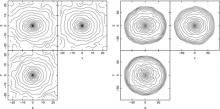
Abstract
Self-consistent solutions for triaxial mass models are highly non-unique. In general, some of these solutions might be dynamically unstable, making them inappropriate as descriptions of steady-state galaxies. Here we demonstrate for the first time the existence in triaxial galaxy models of an instability similar to the radial-orbit instability of spherical models. The instability manifests itself when the number of box orbits, with predominantly radially motions, is sufficiently large. N-body simulations verify that the evolution is due neither to chaotic orbits nor to departures of the model from self-consistency, but rather to a collective mode. The instability transforms the triaxial model into a more prolate, but still triaxial, configuration. Stable triaxial models are obtained when the mass contribution of radial orbits is reduced. The implications of our results for the shapes of dark-matter halos are discussed.